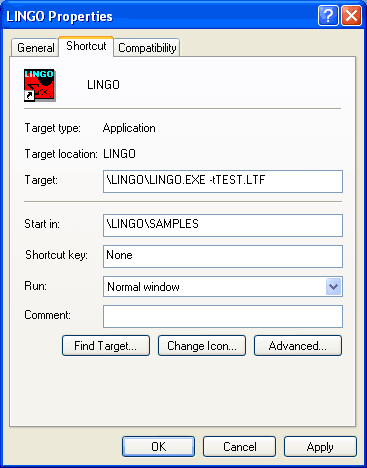Specifying Files in the Command-line
When a Windows version of LINGO starts up, it checks the command-line for the presence of the following three commands:
Command |
Action at Runtime |
-Tfilename |
LINGO executes a File|Take Commands command on the script file filename. If an AUTOLG.DAT file is present in LINGO's working directory, it will be queued for execution before filename. |
-Ofilename |
LINGO performs a File|Open command on filename, reading the file into a standard window. |
-Lfilename |
LINGO executes a File|Log Output command, causing all output that would normally have been sent to the command window to be routed to filename. |
As an example, suppose we have the following command script:
! Input a small model
MODEL:
MAX = 20 * X + 30 * Y;
X <= 50;
Y <= 60;
X + 2 * Y <= 120;
END
! Terse output mode
SET TERSEO 1
! Solve the model
GO
! Open a file
DIVERT SOLU.TXT
! Send solution to the file
SOLUTION
! Close solution file
RVRT
! Quit LINGO
QUIT
Command Script: TEST.LTF
This script file inputs a small model, solves it, and then writes a solution report out to the file SOLU.TXT. Let's suppose the script file is titled TEST.LTF. We can instruct LINGO to automatically execute this file by adding the following command to LINGO's command-line: -tTEST.LTF. To do this under Windows, you will first need to create a shortcut icon for LINGO. Click the right mouse button on your desktop, and then select the New command followed by the Shortcut command. Press the Browse button and then select the LINGO application file, which is found under the name LINGO.EXE in your main LINGO directory. You should now have a LINGO shortcut icon on your desktop that looks like:

To edit the command-line you must right click on this icon and then select the Properties command. You will then see the dialog box:

In the Target edit box, add the command -tTEST.LTF. If you want LINGO to run without opening up a window, you can also select the Minimized option from the Run list box. Now, click the Apply button followed by the OK button.
You can now run LINGO and have it execute the script file by double clicking the shortcut icon on the desktop. Once you have done this, the solution file, SOLU.TXT, should contain:
Variable Value Reduced Cost
X 50.00000 0.000000
Y 35.00000 0.000000
Row Slack or Surplus Dual Price
1 2050.000 1.000000
2 0.000000 5.000000
3 25.00000 0.000000
4 0.000000 15.00000
File: SOLU.TXT
